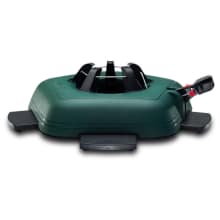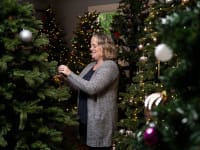Is your Christmas tree covered in mold? Here's what to do
What's lurking in those branches?
Products are chosen independently by our editors. Purchases made through our links may earn us a commission.
There are few things more festive this time of year than a beautifully decorated Christmas tree. But, according to experts, your tree could be bringing more than just joy into your home—it could also be bringing mold.
It's something that allergists have dubbed "Christmas tree syndrome," and most people are totally unaware that a Christmas tree mold can cause sneezing and sniffling.
Here's what you need to know about the mold that could be growing in your tree and how to stay sniffle-free.
What causes Christmas tree mold?
Many live trees have mold spores on the pine needles. When a tree is brought into your warm home, the heat plus any condensation in the air creates the perfect environment for those spores to grow into full-blown mold. Contrary to what you may think, the danger isn't relegated to fresh, live trees; Christmas tree mold can grow on artificial trees that sit in a humid attic year-round. If you do have an artificial tree, make sure you store it properly.
One study analyzed 23 bark and pine needle samples and discovered 53 different types of mold spores, including aspergillus and penicillium, both of which can cause allergic reactions.
During another study, researchers measured 800 mold spores per cubic meter when a tree was first brought inside—and then compared it to the number of mold spores two weeks later, which had grown to 5,000 (!!) spores per cubic meter.
How to prevent Christmas tree mold
For getting rid of Christmas tree mold on live trees, experts recommend rinsing it with a vinegar and water solution before bringing it inside or blowing it off with a leaf blower. You can also wipe down the trunk with the same vinegar solution or diluted bleach.
Once your Christmas tree is in your home, a good rule of thumb—according to allergists—is to only leave it up for about a week. This reduces the risk of mold growing on the branches.
When it comes to an artificial tree, always shake it out or dust it off before putting it up. It's also best to store your tree (and any other Christmas décor) in a temperature- and humidity-controlled area to prevent mold growth.
Other Christmas tree safety tips

A solid stand is a must-have to protect your tree and your home.
Before you even bring your tree into your home, don't just check for Christmas tree mold. Check it for bugs too, recommends our senior manager of lab operations, Jonathan Chan. "People forget that Christmas trees grow outside and can carry tons of spiders, ants, and other creepy crawlies," he explains. "One year, we got a tree in and it was covered in slugs!"
Not only is a bug-infested tree disgusting, it's also dangerous. "Being surprised by insects can startle you and cause you to knock the tree over," Jonathan warns.
If you have a real tree, be sure to water it heavily and often to keep it alive and strong. As a real tree dies, it becomes even more of a fire hazard than it is already.
To prevent tipping your tree (which can cause damage or, worse, start a fire), Jonathan suggests investing in a sturdy tree stand.
Of all the stands we've tested, we like the Krinner's Tree Genie Christmas Tree Stand the most for easy set up. It can safely hold a tree up to 8 feet tall and withstood a lot of weight before knocking over.

Setting up your Christmas tree has never been easier with the Krinner's stand.


